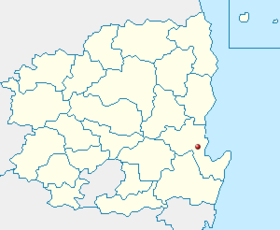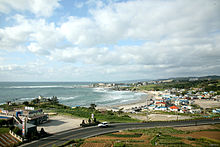- Pohang
-
Pohang
포항— Municipal City — Korean transcription(s) – Hangul 포항시 – Hanja 浦項市 – Revised Romanization Pohang-si – McCune-Reischauer P'ohang-si A view of Guryongpo Beach 
Emblem of PohangCountry  South Korea
South KoreaRegion Yeongnam Administrative divisions 2 gu, 19 dong, 4 eup, 10 myeon Area – Total 1,127.24 km2 (435.2 sq mi) Population (2011 Jul) – Total 520,305 – Density 461.6/km2 (1,195.5/sq mi) – Dialect Gyeongsang Pohang is a city in North Gyeongsang Province, South Korea, and a main seaport in the Daegu-Gyeongbuk region. The built-up area of Pohang is located on the alluvium of the mouth of the Hyeongsan River. The city is divided into two wards ("Gu"), Buk-gu (Northern Ward) and Nam-gu (Southern Ward).
This city has the largest population of Gyeongbuk and it has the 3rd widest land of South Korea.[1]
Contents
History
The earliest evidence of human occupation in the Pohang area is from the Mumun Pottery Period (1500–300 BC). Archaeologists have unearthed small villages and megalithic burials (dolmens) from this period. Still a small fishing village at the dawn of the 20th century, the earliest steps toward developing Pohang into a place of greater significance were taken in 1930 with the construction of a modern harbour. Pohang grew rapidly afterward, attaining the designation of a Town in 1931 and then earning the status of a City in 1949.[1]
Pohang's road arteries and shipping port made it a place of strategic significance during the Korean War. An unopposed landing of UN forces at Pohang on July 18, 1950 was the first large-scale amphibious operation since World War II, and the region around Pohang saw fierce clashes between South Korea's 3rd Infantry Division and North Korea's 5th Infantry Division during August–September 1950.[2]
By the 1960s, Pohang was a small coastal city with a population of 50,000.[3] The next major development in Pohang's growth came in 1968 with the inauguration of the steel maker POSCO, and the local plant's commencement of production in 1972. The introduction of heavy industry to the city brought the local economy to a blend of iron, steel, shipbuilding and fisheries through the end of the 20th century.[4]
The early 21st century and the age of globalization has brought new economic challenges to companies such as POSCO, giving rise to beliefs that Pohang would be wise to not be overly reliant on heavy industry to maintain its prosperity.[5] In response, the Pohang of today presents itself as having an eye to the future, striving to become a diversified city of environmentalism and advanced learning, as well as a centre of arts and culture.[6]
Geography and climate
The mean temperature in the coldest month, January, is relatively mild at 1.8°C. The warmest month is August, when the mean temperature is 25.7°C [7]. On average, Pohang receives 1,152mm of precipitation per year. The driest month is December, when the city receives a scant 25.7mm of precipitation on average. However, the mean amount of precipitation for the wettest month, August, is 227.4mm [8].
Climate data for Pohang (1981−2010) Month Jan Feb Mar Apr May Jun Jul Aug Sep Oct Nov Dec Year Average high °C (°F) 6.5
(43.7)8.6
(47.5)12.7
(54.9)18.9
(66.0)23.2
(73.8)25.5
(77.9)28.7
(83.7)29.4
(84.9)25.3
(77.5)21.4
(70.5)15.2
(59.4)9.2
(48.6)18.7 Daily mean °C (°F) 1.8
(35.2)3.8
(38.8)7.9
(46.2)13.8
(56.8)18.2
(64.8)21.4
(70.5)24.9
(76.8)25.7
(78.3)21.6
(70.9)16.6
(61.9)10.3
(50.5)4.4
(39.9)14.2 Average low °C (°F) −2
(28)−0.3
(31.5)3.7
(38.7)9.2
(48.6)13.8
(56.8)17.9
(64.2)22.0
(71.6)22.9
(73.2)18.4
(65.1)12.5
(54.5)6.1
(43.0)0.4
(32.7)10.4 Precipitation mm (inches) 36.5
(1.437)40.8
(1.606)60.9
(2.398)68.9
(2.713)85.2
(3.354)141.6
(5.575)203.2
(8)227.4
(8.953)177.1
(6.972)43.7
(1.72)41.1
(1.618)25.7
(1.012)1,152.0
(45.354)% humidity 49.1 51.8 57.0 57.9 64.6 73.9 78.7 78.8 75.9 65.5 57.6 51.0 63.5 Avg. precipitation days (≥ 0.1 mm) 5.4 6.2 8.7 8.0 8.8 9.7 13.4 12.6 10.9 6.6 5.7 4.3 100.3 Sunshine hours 188.7 176.4 189.9 214.0 223.9 183.7 161.1 170.3 154.5 193.7 182.8 190.4 2,229.6 Source: Korea Meteorological Administration [2] Transportation
The city is served by several trains a day from Seoul and Daegu. Pohang is the terminus for a number of ferry routes serving the adjacent Sea of Japan (East Sea), including the main tourist route for Ulleung Island. It is also the northern terminus of the Donghae Nambu Line south to Busan.
Pohang is the home of POSCO (the Pohang Steel Company), one of the largest steel producers in the world, and a host of related industries. As a result the port shipped a total of 54.8 million tons in 2006.[9]
Several flights per day to Seoul Gimpo Airport are available at Pohang Airport.
Local transportation is served by only city buses. They run about 20 different ways of the city and some of them reach to the mountain folk. Also, the buses are classified into 2 kinds – one is Ilban-bus(normal bus) and the other is Jwaseok-bus(full of seats and a little more expensive than Ilban-bus). They run 15~25 minutes intervals along their own way. The bus routes are listed in both Korean and English but the Korean version is interactive, and thusly more helpful.
There are two main bus terminals - Shiwae (시외) and Gosok (고속) which roughly translate into intercity/city and express. The Shiwae bus terminal (시외버스터미널) also acts as the cross-country bus terminal from which you can easily travel to nearby metropolitan cities such as Daegu and Busan (~1.5 hrs each depending on traffic). Their website is only in Korean and only accessible in Internet Explorer. The Gosok bus terminal (고속버스터미널) website is in both English and Korean. From Gosok bus terminal one can travel to Seoul, Gwangju, Seosan, Masan, and Daejeon.
Pohang is also serviced by two train stations - Pohang station (포항역) and Hyoja station (효자역). Pohang station is only a 5 minute walk from Jukdo Market. Times and destinations are available on the Korail website which is in English and Korean.
Education
Universities with graduate schools
Other institutes of higher education
- Pohang College
- Sunlin College
Pohang Culture
The city is home to the K-League football club Pohang Steelers.
Thousands flock to see the fireworks festival at Bukbu Beach each summer. People travel from all over the country to watch the show.
The Culture & Arts Center, opened in 1995, holds performances and exhibitions in its various galleries and theaters.
Points of interest
The Jukdo Market is a large, bustling traditional market near the centre of the city, close to the port. It is well-known throughout Korea as an important seafood market. There are a large number of raw-fish restaurants in the market. The fish is cheaper than Seoul or Daegu.
Bukbu Beach is located in Duho-dong in the northern part of the city's built-up area. The beach front has been the focus of commercial developments such as bars, restaurants, and budget accommodations called Yeogwan. A number of beaches on the East Sea can be found just north of the built-up area, including Chilpo and Wolpo.
Homigot, a point of land jutting out into the Sea of Japan (East Sea), is located to the east of urban Pohang in Daebo-myeon. Homigot is one of the easternmost points on the Korean peninsula and as such serves every year as a gathering place for thousands to greet Korea's first sunrise of the New Year. The beach is also home to the famous Hands of Harmony sculpture.
Bogyeongsa is a major Buddhist temple nestled in a steep green valley at the foot of Mount Naeyeon (710 m) in Songna-myeon, an area in the extreme northern part of Pohang. Yeonsan Waterfall is located nearby in the same mountain valley. There are hiking trails leading from the temple up into the mountains. Bogyeongsa also has a number of mountain hermitages in the vicinity.
Oeosa is a temple located in the extreme southern part of Pohang, just inside the mountains south of the coastal plain formed by the Naengcheon River. It is located at the foot of Mt. Unjae (481 m) in a steep valley in Daesong-myeon. Signs placed in and around Oeosa claim that the temple was founded by Wonhyo, the well-travelled Silla monk.
Notable people
Pohang is the home town of South Korean President, Lee Myung-bak
And, Professional South Korean Mixed Martial Artist Jung Chan-Sung Trains in Pohang at Korean Top Team.
Shopping
The main downtown shopping area is between Yukgeori (육거리) and Ogeori (오거리) which translate to 6-way intersection and 5-way intersection. The streamlet boardwalk shopping area is opens and ends with Pohang Station and Yukgeori, respectively. This shopping area has several stores, restaurants, and a few bars including Converse, Shoemarker, Skin Food, ABC Mart, Redface, Northface, a cinema, Starbucks, Mr. Pizza, Whistler Bar, Beethoven Bar, Mindy's Bar, and etc.
Groceries
Pohang has a few major grocer stores including two Home Plus locations, two GS Supermarkets, and two E-marts. One Home Plus is by the Shiwae bus terminal and the other is closer to Jukdo Market. Jukdo market is an open market where you can purchase clothes, fish, produce, and a plethora of items. The one GS supermarket is in Jukdo-dong whereas the other is in Duho-dong. The E-mart is located in I-dong and in Indeok-dong.
Administrative districts
- Buk (North)-gu
- Nam (South)-gu
Sister cities
Pohang is a sister city of the following cities around the world.
 Hunchun, China
Hunchun, China Gwangyang, South Korea
Gwangyang, South Korea Suwon, South Korea
Suwon, South Korea Long Beach, United States
Long Beach, United States Pittsburg, United States
Pittsburg, United States Fukuyama, Japan
Fukuyama, Japan
Friendly co-operative cities
Pohang is a friendly co-operative city of the following cities around the world.
 – North Shore City, New Zealand (August 2008)
– North Shore City, New Zealand (August 2008)
See also
References
- ^ First is Andong, and 2nd is Gyeongju.
- ^ "평년값자료(1981−2010) 포항(138)". Korea Meteorological Administration. http://www.kma.go.kr/weather/climate/average_30years.jsp?yy_st=2011&stn=138&norm=M&x=28&y=7&obs=0&mm=5&dd=23. Retrieved 2011-05-23.
External links
North Gyeongsang 
Capital Cities Counties Metropolitan cities of South Korea Special city Metropolitan cities Provincial capitals with gus
(not included above)Provincial capitals without gus
(not included above)Cities with gu
(not included above)Cities
(not included above)Andong · Anseong · Asan · Boryeong · Chungju · Dongducheon · Donghae · Gangneung · Geoje · Gimcheon · Gimhae · Gimje · Gimpo · Gongju · Gumi · Gunpo · Guri · Gunsan · Gwacheon · Gwangju · Gwangmyeong · Gwangyang · Gyeongju · Gyeongsan · Gyeryong · Hanam · Hwaseong · Icheon · Iksan · Jecheon · Jeongeup · Jinju · Miryang · Mungyeong · Namwon · Namyangju · Naju · Nonsan · Osan · Paju · Pocheon · Pyeongtaek · Sacheon · Samcheok · Sangju · Seogwipo · Seosan · Siheung · Sokcho · Suncheon · Taebaek · Tongyeong · Uijeongbu · Uiwang · Wonju · Yangju · Yangsan · Yeongcheon · Yeongju · YeosuCoordinates: 36°01′56″N 129°21′54″E / 36.03222°N 129.365°E
Categories:- Cities in Gyeongsangbuk-do
- Pohang
Wikimedia Foundation. 2010.



